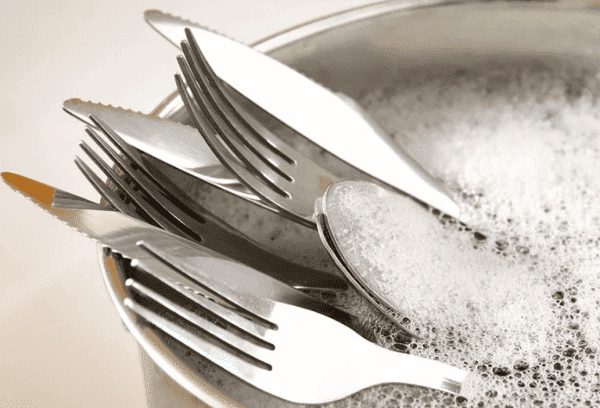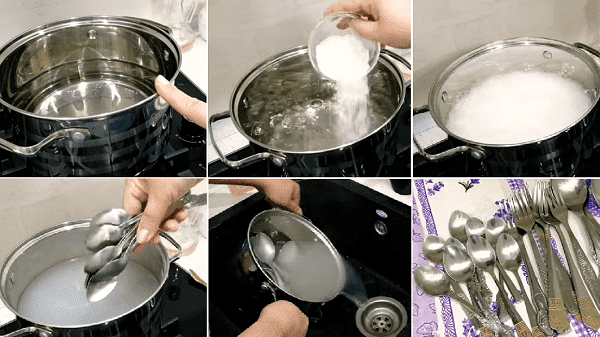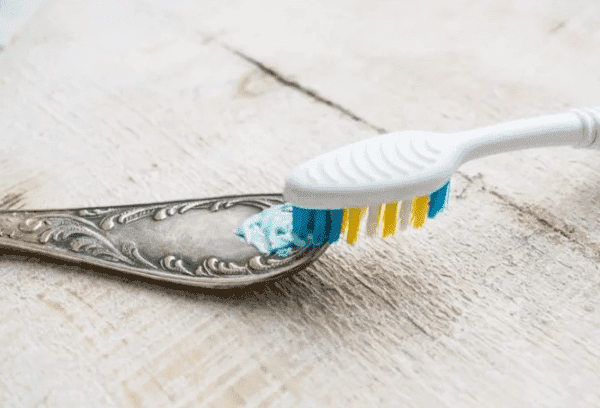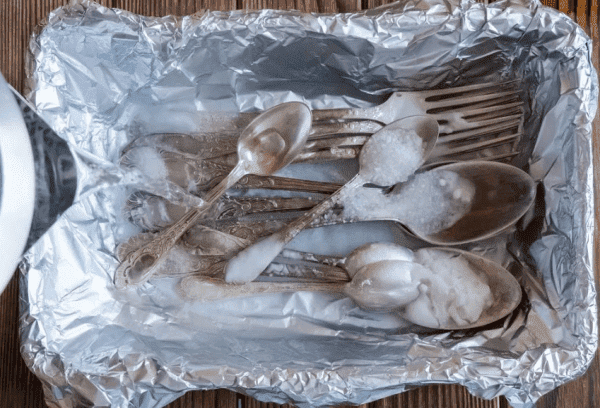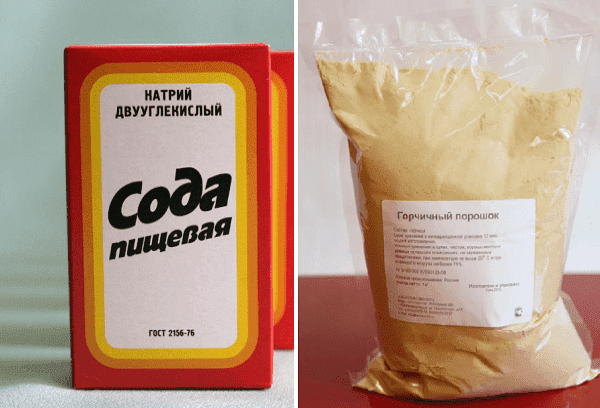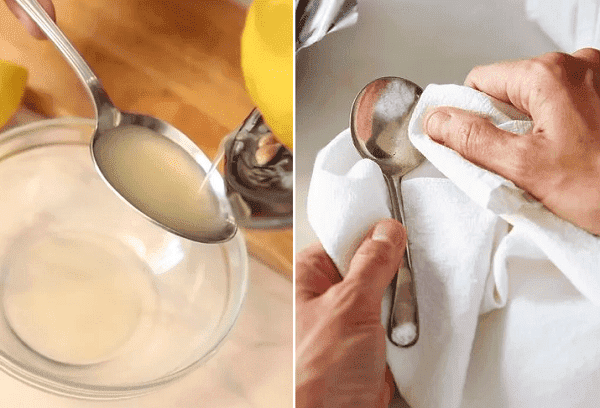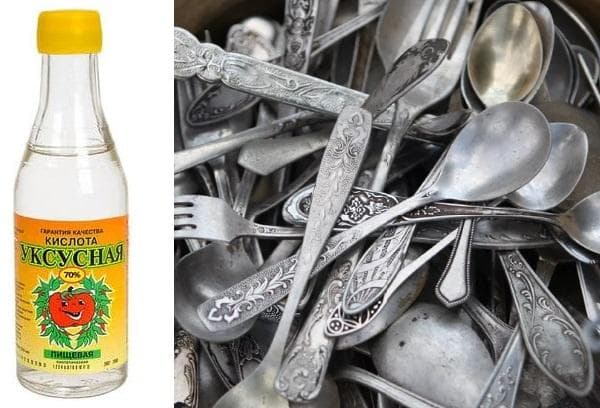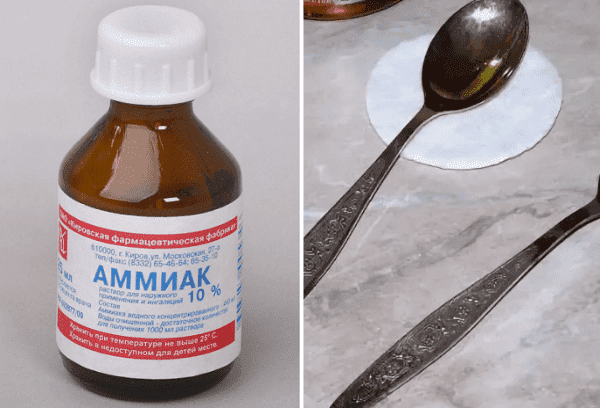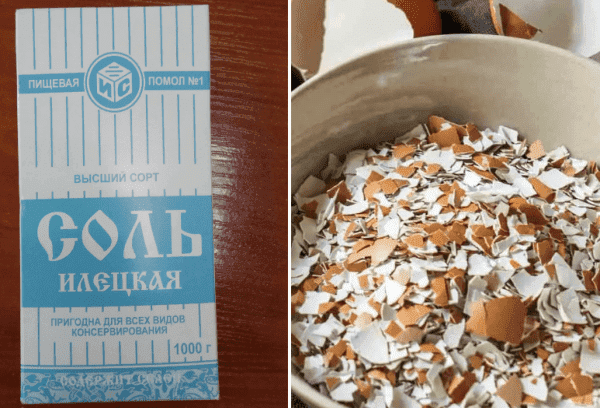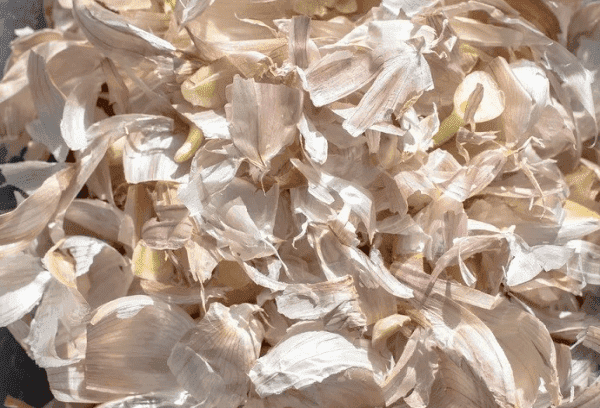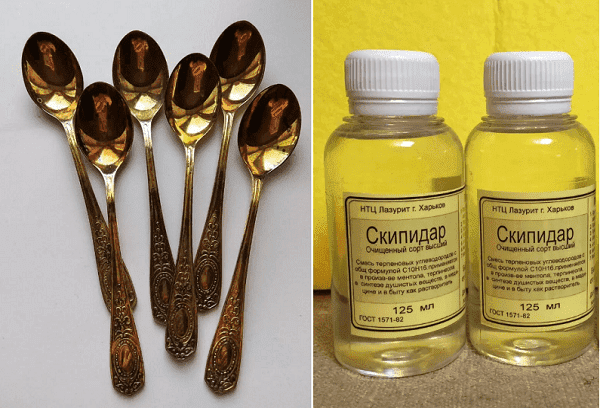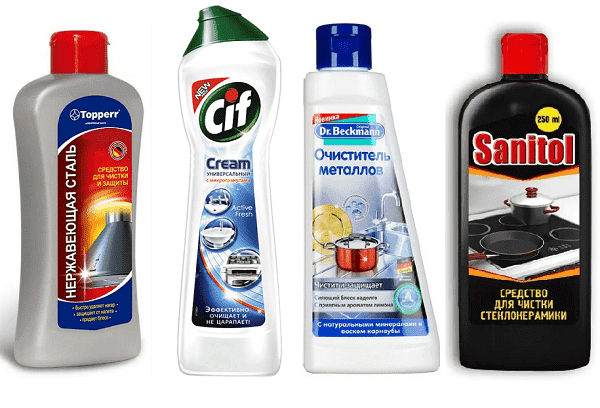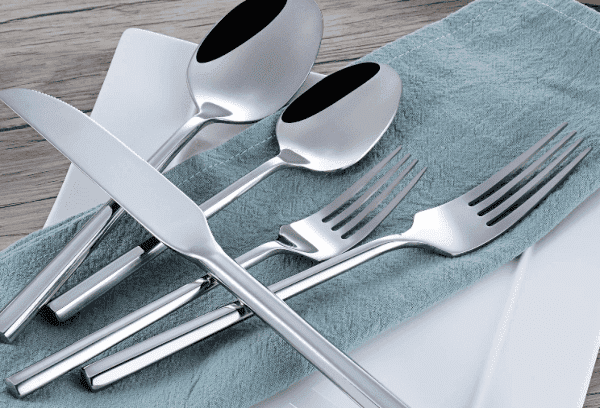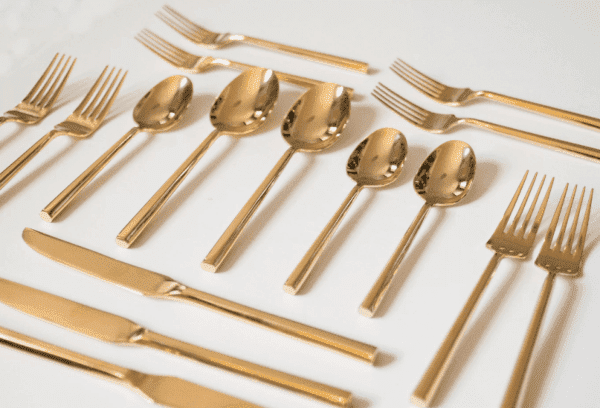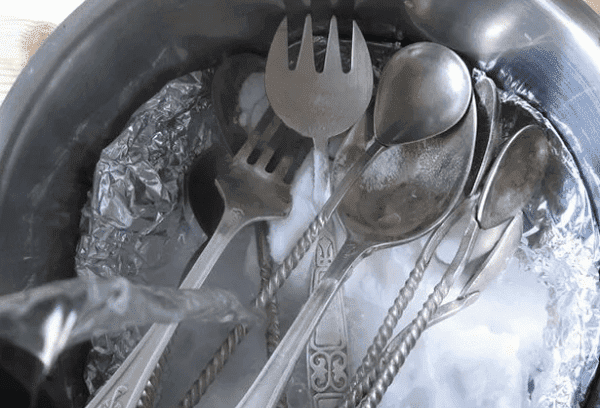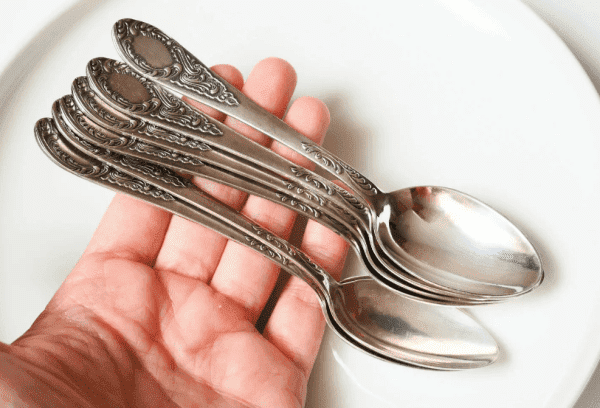How to clean spoons and forks from blackness and plaque so that they shine - simple methods
Content:
Over time, cutlery loses its original shine, sometimes becoming covered with blackness and plaque. You can clean spoons and forks yourself using products found in every home. The method is chosen depending on the material of the cutlery. Spoons and forks plated with gold require more delicate handling than items made of stainless steel or cupronickel.
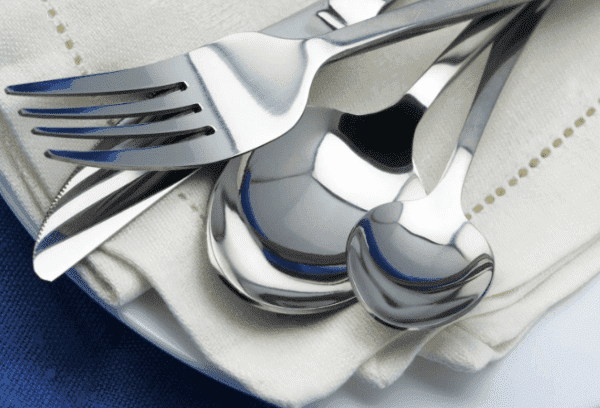
How to clean spoons and forks with home remedies
If you wish, you can clean spoons and forks using home remedies without resorting to purchasing expensive products. How often the procedure should be carried out depends on the appearance of the devices. If they are covered with plaque, dark spots, or simply lost their shine, it’s time to get down to business.
Boiling
Boiling in ordinary water is more of an auxiliary cleaning method.By boiling, you can soften old plaque on spoons and forks made of stainless steel and other metal. Softened dirt stuck between the elements of the relief surface can then be easily removed with a soft cloth or sponge.
To remove dirt between the teeth, you can use an old toothbrush with dish soap on the bristles.
It is not necessary to boil the appliances on the stove; you can simply pour boiling water over them and place them in a saucepan. This method is used when the forks and spoons are not too dirty. If boiling, keep the appliances on the stove for no longer than 30 minutes. Then they are rinsed in clean water.
Soda, citric acid
You can clean forks and spoons at home with soda and citric acid. First, both products are dissolved in hot water. In order to prepare 2 liters of solution, you will need 2 teaspoons of soda and 1 teaspoon of citric acid.
To clean the devices from dirt, soak them in the prepared mixture for 15 minutes. If there is a large accumulation of dirt, the product can be left longer. To prevent the solution from cooling, place the pan on low heat.
The same tool will help rid appliances of blackness. Boil the blackened forks and spoons in the solution for 5 minutes. After rinsing the products, they must be immediately wiped dry, otherwise a whitish coating may remain.
Toothpaste, powder
When cleaning serving dishes, choose one product - toothpaste or powder. In this case, the cleaning composition should not contain large abrasive particles and bleaching components.
The devices should be cleaned in the following order:
- Hot water is poured into a deep bowl.
- Soak contaminated utensils for 5 minutes.
- Taking forks and spoons out of the water one by one, remove plaque from them using powder or toothpaste.
- Clean dishes are rinsed in water.
To reduce the consumption of powder, you can prepare a liquid paste from it by mixing it with a small amount of hot water. It is not possible to quickly clean the devices in this way, since they are processed individually.
Foil, soda, salt, boiling water
Foil is usually used to clean silver and stainless steel utensils. This method allows you to bring the dishes to a shine. The method with foil involves placing it on the bottom of the pan, after which teaspoons and tablespoons, forks, and knives are placed there.
Then dissolve 1 teaspoon of salt and soda in a liter of water. The solution should completely cover the devices. Place the pan on the stove and boil for 15 minutes. After this, you can rinse the serving dishes in clean water and wipe dry.
Mustard, soda
You can bring the devices to such a state that they shine by soaking them in a solution of mustard powder and soda. 1 tbsp. A spoonful of both components is dissolved in 1 liter of very hot water. Then the serving dishes are placed in the solution for 30 minutes.
If it is not possible to get rid of old fat particles, the soaking time is extended. Cleaned spoons and forks are washed in clean water; if dirt remains in some places, you can rub these places with a sponge and dishwashing detergent.
Lemon juice
Lemon juice is used when you need to remove blackness from gold-plated or silver-plated forks and spoons. Natural citric acid acts gently without damaging the coating.
To begin, cut the citrus fruit in half and squeeze the juice into a cup. To clean the devices, use a rag or other soft cloth.The cloth is soaked in lemon juice and then wiped over the darkened serving utensils. If the blackness doesn't budge, you can use an old soft-bristle toothbrush. This method can usually whiten even neglected appliances.
Vinegar
Vinegar dissolves grease well and removes dark spots. With this product, you can rub your appliances to a shine using a piece of soft cloth. Hands must be protected with rubber gloves to prevent skin damage.
Fat particles stuck between decorative elements are removed by soaking the devices in a vinegar solution (125 ml of vinegar per 1 liter of water). The forks and spoons filled with the mixture are placed on the fire and brought to a boil, after which the pan is removed from the heat and covered with a lid. When the vinegar solution has cooled, rinse the devices in clean water and wipe with a towel.
Ammonia or ethyl alcohol
You need to use one or the other. Ammonia is a rather aggressive liquid; devices should not be soaked in it, but rather wiped with ammonia using a rag.
A more gentle treatment would be with a solution of ethyl alcohol (add 100 ml of alcohol per 1 liter of water). The serving dishes are soaked in the solution for several hours, then rinsed with clean water and wiped dry. Pure alcohol is used to get rid of individual stains. Apply the product to a cotton pad and then wipe the problem area.
Chalk and ammonia
First you will need to prepare a mixture of crushed chalk and ammonia. The consistency of the composition should resemble liquid sour cream. The method is suitable for cleaning darkened cupronickel devices.
Gold and silver plated items may be damaged by this cleaning method.Cupronickel silver spoons and forks are wiped with a rag soaked in the solution, then they must be washed in water. Clean appliances are removed from residual moisture by wiping with a napkin or towel.
Eggshells and salt
Eggshells and salt will help rid serving utensils of old plaque. Since this composition has abrasive properties, it is used only for cupronickel and stainless steel.
The crushed eggshells are thrown into a pan of boiling water, then 1 tbsp is added here. l. spoon of salt and put cutlery. The boiling process should continue for 5 minutes. After this, the forks and spoons are removed, rinsed and wiped dry.
Garlic peel
A product based on garlic peels is good at removing dark stains and old plaque from dishes. You will first need to make an infusion. The raw materials are collected in advance, then placed in a glass jar and filled with water. After 12 hours, the infusion is brought to a boil and cutlery is immersed in it. Let the forks and spoons sit in the mixture for at least an hour, after which they are washed and dried with a towel.
Turpentine
The product is suitable for cleaning gold-plated dishes. You will have to act slowly, wiping each device with a cotton pad soaked in turpentine. After processing, the product must be washed in clean water. You should not leave spoons and forks damp after the procedure; they should be wiped with a cloth or towel.
Using professional products
When choosing a professional product for cleaning metal products, you need to make sure that it is intended specifically for the metal that is to be cleaned. Liquid products act most delicately. The following gels and sprays are suitable:
- "Sif";
- "Amethyst";
- "Topper"
- "Dr. Beckmann";
- "Sanitol".
Each product has its own instructions; the scheme for their use will be different. Chemical compositions can be safely used for stainless steel and cupronickel. Products made of silver and with applied gilding should be approached individually.
Features of cutlery made from different materials
Cutlery can be made from various metals and alloys. Sometimes the manufacturer uses additional coating to make forks and spoons more decorative. The properties of the material determine the characteristics of the product.
Stainless steel
Stainless steel cookware and appliances began to be produced after the invention of the 18/10 alloy, which contains 18 parts chromium and 10 parts nickel. Stainless steel immediately created a sensation.
Utensils made from this metal:
- does not oxidize like aluminum;
- does not become rusty;
- has an attractive shine.
Stainless steel has low thermal conductivity, which means the risk of getting burned by hot food when using cutlery is reduced. Stainless steel products can be easily given a variety of shapes, so the design of cutlery can be quite sophisticated.
To further refine the forks and spoons, they can be coated with silver and gold and artistic painting can be applied. Regular stainless steel cutlery does not require complex care and can be washed in the dishwasher. Products with complex shapes and original decor require additional cleaning.
Gold plated
Cutlery made of silver, cupronickel, and stainless steel can be plated with gold. Such products are intended for special occasions; they are not used daily.The thicker the gilding layer and the less often the devices are used, the more durable the decorative coating will be.
You need to take care of gold-plated items with care. They are washed by hand, and then the shine is restored to the devices by polishing them with a suede cloth. The choice of care products for such spoons and forks should be approached carefully. Aggressive compounds are not suitable for gold-plated metal.
Silver
Silver cutlery is prized for its antibacterial properties. In addition, such products look aesthetically pleasing and expensive. A collection of silver spoons can be given as a valuable gift.
Noble metal requires careful handling. Silver cutlery should not be washed in the dishwasher; chlorine-containing products should not be used to clean it. Due to improper care, the metal may become cloudy.
Cupronickel
Cupronickel silver devices are made of a copper-nickel alloy, the ratio of components in which can vary. Cupronickel silver spoons and forks are often coated with gold or silver. There is a misconception that cupronickel devices can be harmful to health, this is not true.
The advantages of products made from this alloy include the fact that they look expensive, do not corrode, and can last from generation to generation. Cupronickel has low thermal conductivity. The disadvantage of metal is that it can darken if there is excess moisture. In general, the material is more demanding to maintain compared to stainless steel.
Tips for caring for cutlery
It is better to wash all cutlery immediately after use, avoiding dirty dishes lying in the sink. In this case, plaque will form on spoons and forks much more slowly.Do not scrub the metal with wire wool or use coarse abrasive substances, otherwise the serving items will become scratched and lose their shine.
Each dishwashing should end with rinsing the appliances, after which they should be wiped dry. It is unacceptable to use concentrated acid for cleaning purposes; it may react with the metal. Forks and spoons containing plastic, stone, or plexiglass in their decoration should not be boiled. They are simply soaked for 30-40 minutes in hot soapy water.
Proper use and regular care will help keep your cutlery in perfect condition for many years. Both folk and professional products can be used to clean products. After the cleaning procedure, forks and spoons are rinsed with clean water and be sure to wipe.
